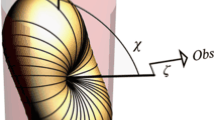Abstract
GOLD1 has proposed an interesting model for pulsars, which goes a long way towards explaining some of their more baffling properties. His model, briefly, is that pulsars are rapidly rotating neutron stars, with an axially asymmetric magnetic field “frozen in” to the star, and thus rotating with it. A plasma surrounds the star and co-rotates with the magnetic field, out to, or nearly out to, the critical radius at which the tangential velocity would be the velocity of light. Relativistic effects in this rapidly spinning plasma are to account, in a general way, for the radiation emitted. The exact mechanism is not specified, although charges embedded in the plasma are mentioned.
Similar content being viewed by others
References
Gold, T., Nature, 218, 731 (1968).
Author information
Authors and Affiliations
Rights and permissions
About this article
Cite this article
GOOD, M. Proposed Test for the Radiation Mechanism of Pulsars. Nature 221, 250–251 (1969). https://doi.org/10.1038/221250a0
Received:
Issue Date:
DOI: https://doi.org/10.1038/221250a0
- Springer Nature Limited
This article is cited by
-
Nature of the radio wavelength emission from pulsars
Astrophysics (1974)





